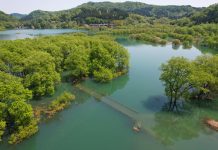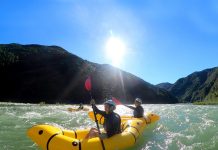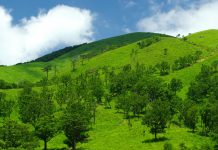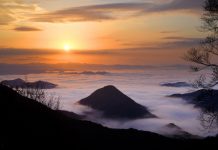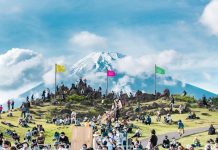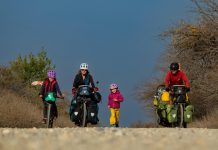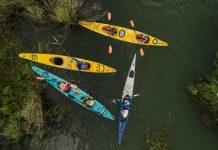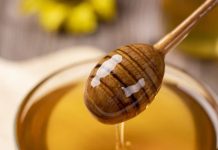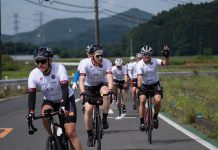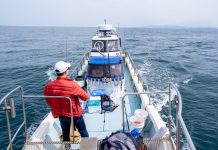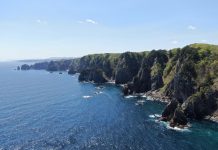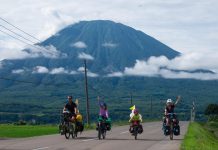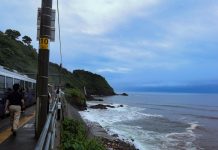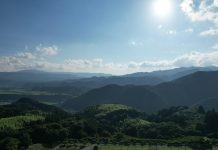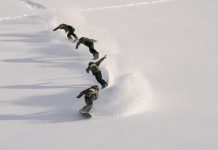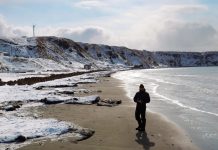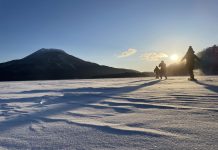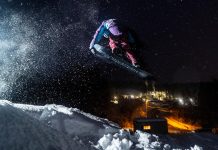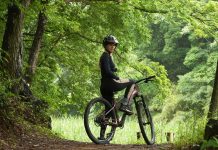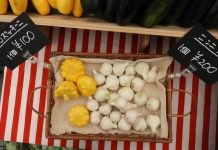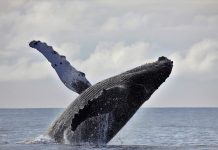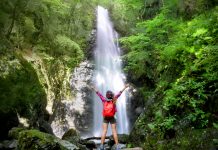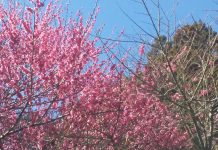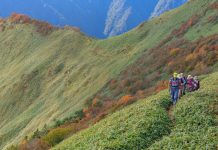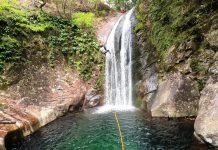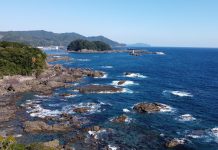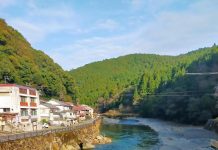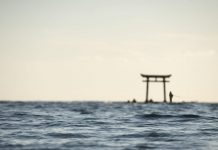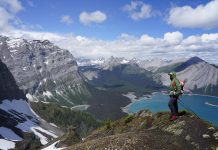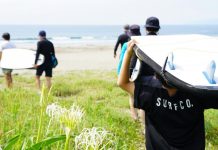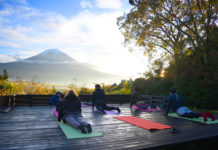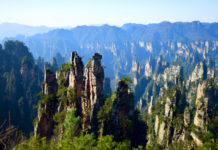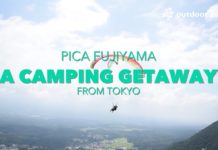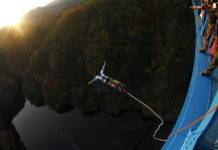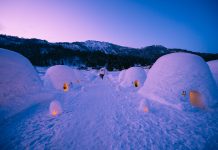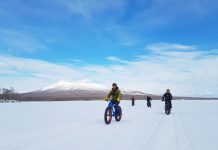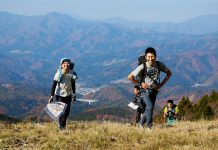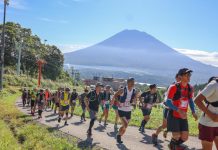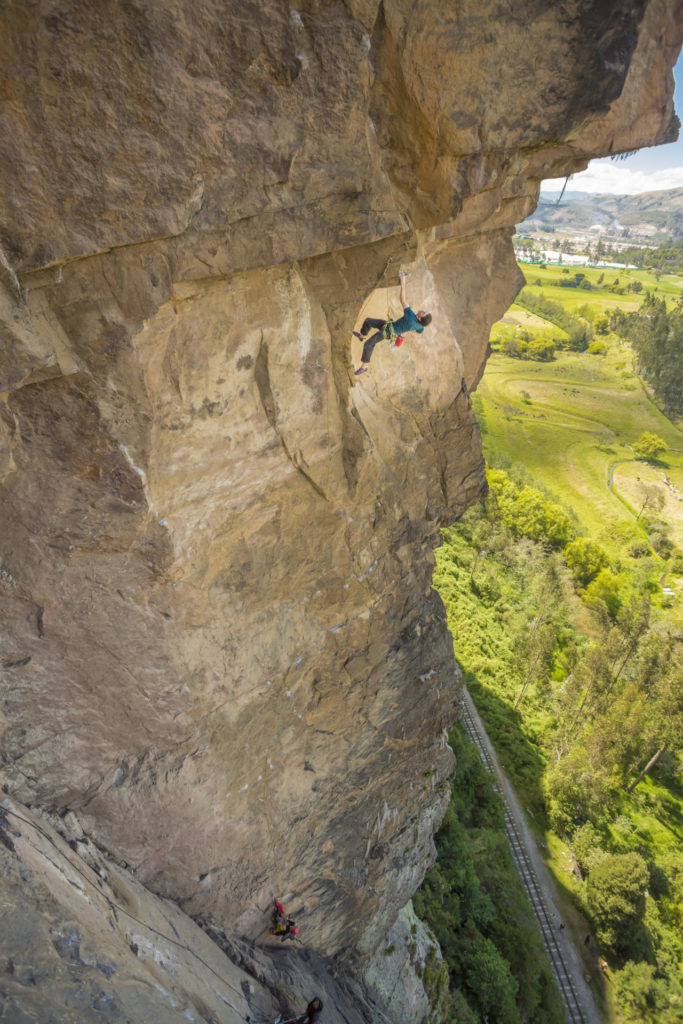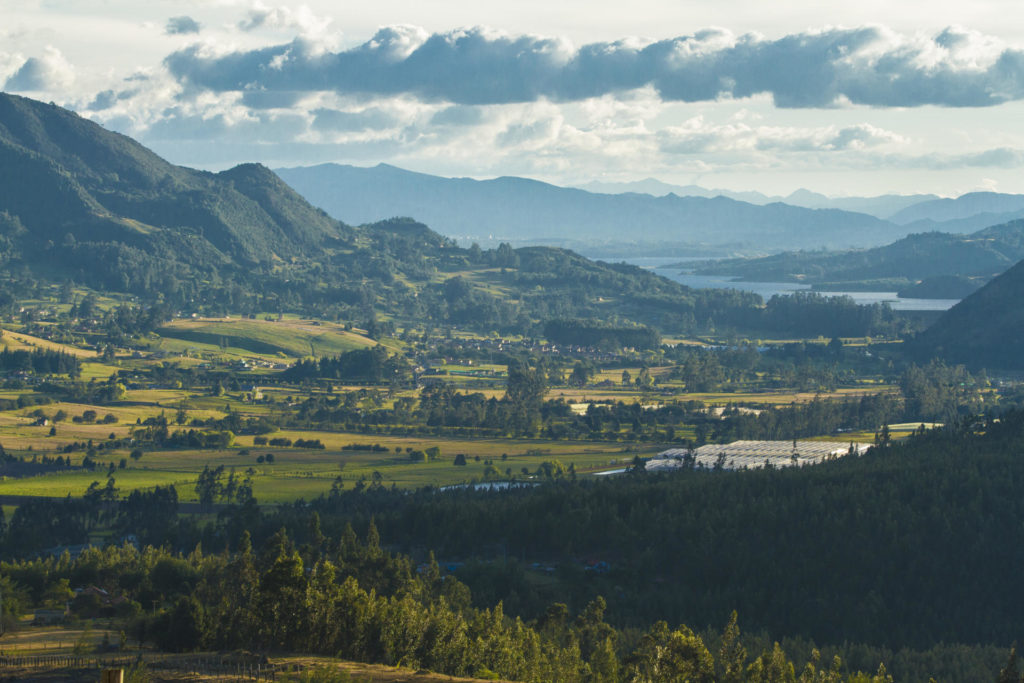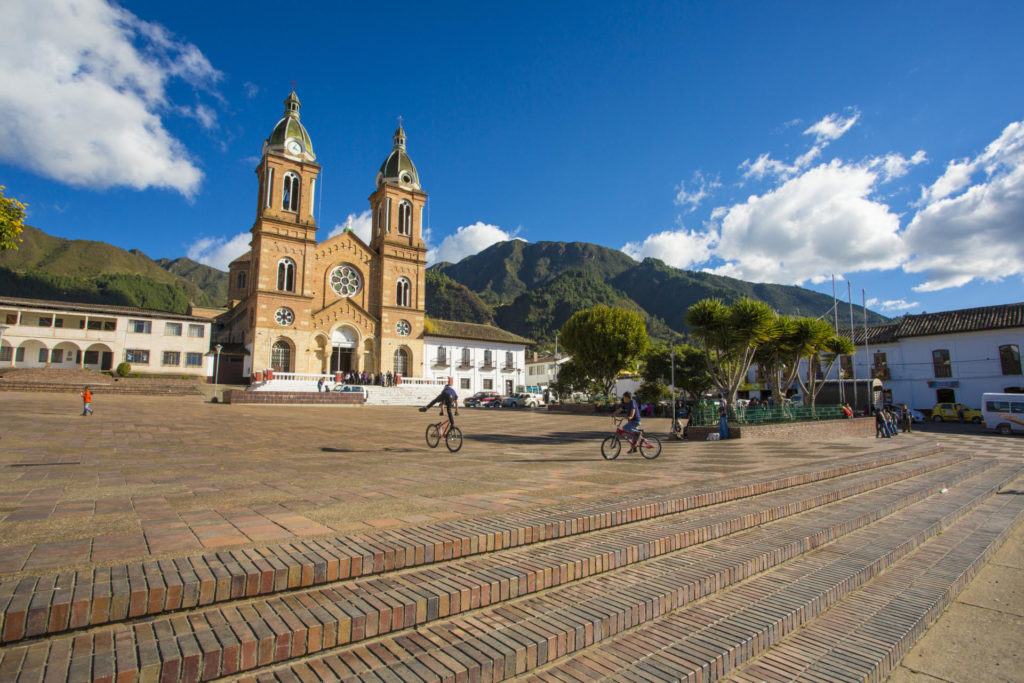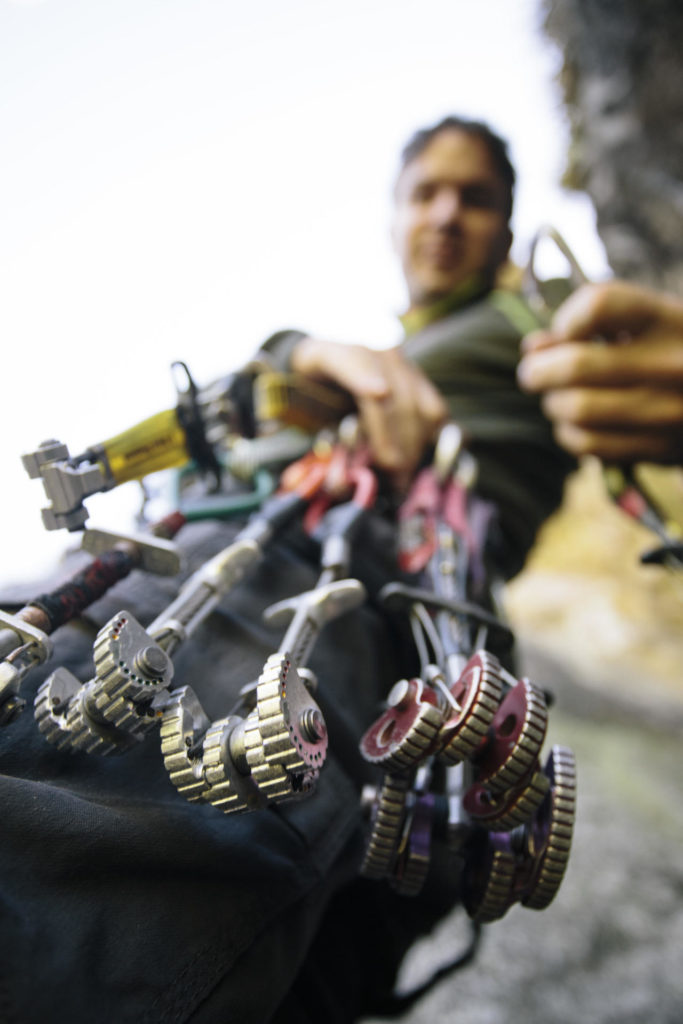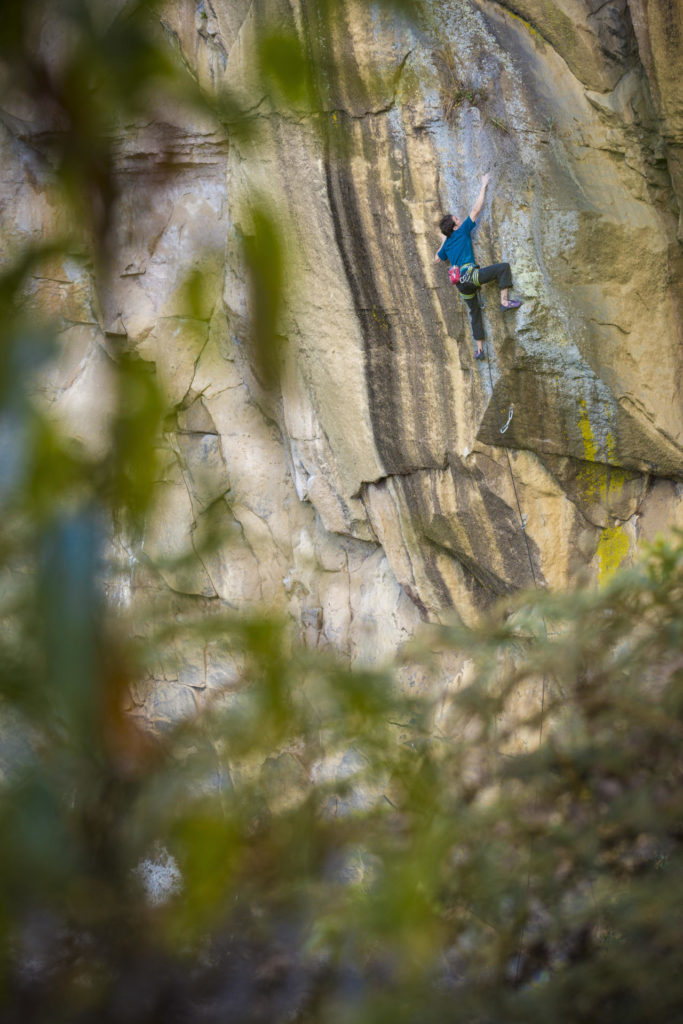While travelers often eschew Colombia for presumably safer options in the region, memories of the warmhearted people and challenging steep rock walls had beckoned and I was finally able to answer the call for another Colombian climbing adventure.
The driver of our white van grinds through his gears as we pass through the town of Puente Nacional. We’re in northwest Colombia traveling on tight, steep roads on the way to Florián and the crags of La Ventana for steep sport climbing. A puppy narrowly avoids the wheels of the van. We pass two men standing in fatigues holding rifles who give us a thumbs-up, indicating it’s safe ahead.
The open glass window jiggles by my ear. We rattle by a colonial-style brick building, a painting of Homer dressed as Santa riding a tricycle, and sleeping dogs. The pavement ends, and we hit a rough dirt road riddled with sharp rocks. Thick jungle replaces city. The van springs creak as we sway and continue to rumble along.
I hear a hiss as the rear tire drains flat. The driver takes off his over-shirt and crawls under the vehicle near a pile of fresh horse manure until only the soles on his worn brown shoes are visible. Soon he teams up with the passengers to replace the tire with the spare located on the roof.
My traveling partners, photographer-videographer Rich Crowder and Adidas Outdoor pro climber Ben Spannuth, jump the nearby barbed wire fence and hike downhill toward a water source. Turning a corner, they come upon more than 50 people swimming and wading in the river. So much for thinking we were in the middle of nowhere.
This is my second trip to Colombia in seven years, and I’ve come back because of the warm people, beautiful landscape and exceptional climbing. In the years since my first visit, it has only become safer here for travelers looking to explore places that, until recently, have been off their radar.
It wasn’t so long ago that Florián, like many parts of Colombia, was not a place for visitors. Three or four years ago, if we three gringos were headed here, we almost certainly would have been taken captive.
Back then, Florián was cocaine country, controlled by paramilitary and guerrillas, but as recently as 2010, progress has been made by the government to improve safety for locals and visitors alike. Violent crime is down. This isn’t to say the drug trade is gone; it is merely less prevalent.
Colombia Drug Violence: Now and Then
Most people associate Colombia with cocaine and violence. The far left guerillas, or FARC (Revolutionary Armed Forces of Colombia), is a terrorist organization funded by the sale of cocaine produced in the jungle for $1,500 a kilo and sold on U.S. streets for $50,000 a kilo. FARC has been at war with the government and the far right paramilitary groups since 1964. Over time, the line separating the guerillas and paramilitary has blurred.
However, in the last eight years as Colombia has become safer, tourism is up, especially since Juan Manuel Santos became president in 2010. Santos has used much of the national budget of this enormous country, which is twice the size of Texas, to place armed military on street corners to protect citizens and visitors. He also regularly holds peace talks among the government, FARC and the paramilitary.
Government operations have incarcerated or extradited to the U.S. an average of 100 drug traffickers per year. Despite these actions, as of 2011, Colombia was still regarded as the world’s largest producer of cocaine and a major exporter of heroin and marijuana.
I look at the remaining tires: they are split and worn. I’m nervous. We soon head off again, having used our only spare. Hours later, with the driver perpetually looking back at the recently replaced tire, we finally reach the cave.
Once off the bus, we walk through a rock awning and into the magnificent cave, crossing a series of bridges to reach the center. A flowing river pours out from the far entrance, and through that opening we see the orange brick buildings and tin roofs of Florián. It is in the distance surrounded by lush jungle. As the sun sets, hundreds of homes surrounding the town light up like fireflies.
This is my second visit to Colombia. Seven years ago a friend, Katty Guzmán, a highly respected member of the Colombian climbing community who I met in Yosemite years before, lured me there. She lives in the mountains in the quiet town of Suesca, located an hour’s drive from Bogotá. She talked about her country, with promises of cheap living, warm people, beautiful and varied land and quality rock climbing. That’s all I had to hear.
During that first month-long visit, I made several life-long friends. Colombians are some of the warmest people I’ve ever met. When they meet someone new, their engaging eye contact and outgoing enthusiasm makes it feel as though you’ve made a close friend. By trip’s end, I couldn’t wait to come back.
The Window
When Ben, Rich and I saw pictures of Florián on the Internet, we made it our primary objective for our visit, mainly because of the images of the nearby limestone cave called La Ventana (The Window), over a waterfall located halfway up a 2,000-foot face.
For the next five days, we climbed at La Ventana, getting pumped out of our minds as we dangled and swung like monkeys along the roof of the cave on the many stalactites. We immediately met locals such as Emerxon Porras Jimenez, our guide to La Ventana (he also works for the local radio station). We also met an 18-year-old named Juan Carlos Camacho Barbosa and his crew who enthusiastically showed us around town. He unfailingly called Rich, Ben and me by the same name, “Macho Man.”
Stranded in the Jungle
We drove up the rough road toward the cliff in darkness. Tension was running high. My climbing partners Rich and Ben had been missing for hours. We were in a remote part of the northern Colombian jungle and several hours from the nearest town. They had been climbing in a cave full of stalactites. I hoped one of the hanging spikes hadn’t fallen on them or cut their rope.
The locals wanted to join the rescue effort, so the car was full. I told them a few of us should stay back so there would be room in the car for Rich and Ben, but they objected, stating they’d rather walk back than miss the rescue. Once at the entrance to the cave, I ran ahead while the others waited for my signal.
I checked one anchor and didn’t see any sign of their ropes. Then I crossed the river, hopped up to a point near the edge of the cliff and found their rope pulled up and piled on the ledge. I called for them, straining my voice over the sound of the 1,000-foot waterfall.
Two voices were barely audible. I threw the rope back over the edge, but it kept hanging up in the jungle. After several tries, I finally felt one of them tug on the end of the rope. Soon Rich pulled over the top by using his ascender. Fire ants were biting him. He was sweating from under his helmet. He’d been there five hours.
It wasn’t supposed to have ended this way. When they hiked out to the crags that morning with local guide, Emerxon, due to miscommunication, Rich and Ben had told him not to keep an eye on their ropes. Also, they had forgotten to fix the low end of their line. While an influx of tourists poured in and out of the cave above them, someone, likely unaware of what the rope was doing hanging over the edge of the cave, pulled it up.
Getting to the Mountains
A few weeks prior, I was on a plane heading from San Francisco to Colombia’s capital city, Bogota. On the flight I met Laura Hortua, an exchange student returning to her home country. She told me it’s rare for visitors to come to Colombia because they are afraid of the drugs and violence. When visitors do come, she said, many of the locals go out of their way to make them feel welcome. That was part of the allure for Ben, Rich and me.
Laura explained that visitors often assume there are drugs everywhere, which is not true. But of course the fears of being taken hostage are not entirely false either. “Just don’t go to those places,” she warns. Then she gives me some pointers.
“Don’t let anyone help you with your bags. Tell them no. Be strict. Another danger is the taxi scam. Call ahead to the taxi service and get their license plate number in advance. Don’t share taxis with other people. Otherwise, someone can get in with a gun, make you go to an ATM and take out all your money.”
Twice robbers have broken into her apartment in Bogotá and taken everything. She learned the hard way about the taxi scam. Despite these incidents, she still chooses to be in Colombia, because she loves the people and the beautiful landscape.
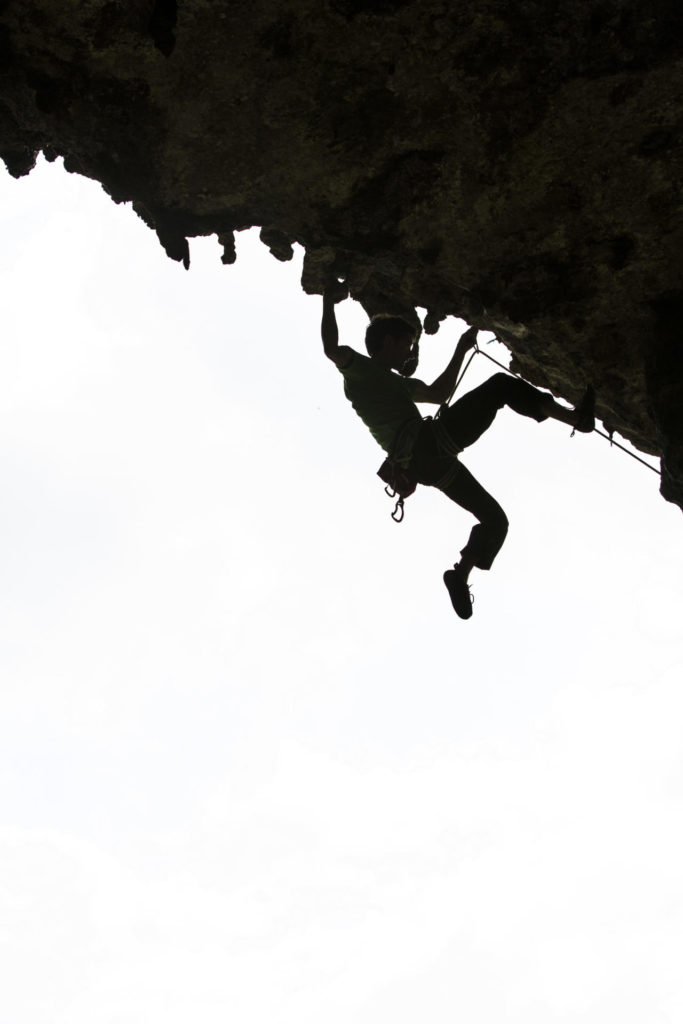
Five Areas to Visit
Bogotá: The nation’s capital offers all the trappings of a major city; shops, boulevards, traffic, cars and people. Street vendors set up shop outside the ubiquitous red brick buildings on nearly every street corner, selling salted unripe mango, and there are pushcarts filled with cigarettes and lollipops. For about $10, catch the Teleférico de Monserrate cable car up to the 10,341-foot summit of Monserrate, home to the 17th century church overlooking the city.
This is also a great place to watch the sunset. For a challenge, run up the 2,690-foot tall steep path. Back in the city, visit the public square Chorro de Quevedo for sightseeing, shopping and eats. Or visit Cafe el Maná (Café of seed/prosperity) offering alcoholic and non-alcoholic drinks—including the best cup of coffee I had in Colombia—plus delicious meals in a candlelit, intimate setting. Bogotá is a good place to stock up on fresh veggies before heading to the remote mountains.
Rocas de Suesca: The rose capital of Colombia, this destination is nearly an hour’s drive from Bogotá. Alongside fields of greenhouses filled with roses is a giant cement factory. Visitors come here to hike along the train tracks and watch the climbers scale the sandstone walls.
The 20-year-old Rica Pizza shop bakes gourmet pizza at about $12 per person, which is two to three times higher than the more expected price at surrounding restaurants. Other nearby options serve traditional Colombian fare such as rice, french fries, and carne (beef) or pollo (chicken) for about $3 per plate.
For additional gourmet food, the best coffee in town and free Wi-Fi, visit Vámonos pa’l Monte (Let’s Go to the Mountains). The spacious/deluxe El Vivac (The Bivouac) hostel for $15 per night offers a clean, spacious place to stay, cook and hang out; it’s merely a 15-minute walk to the town center. For $3, you can camp at the base of the crags.
Machetá: A nearly two-hour drive or three-hour bus ride from Bogotá, Machetá is famed for its thermal hot springs, called El Volcan, and the adjoining hotel. Take a cold bucket shower to clean off your grime—the only place you’ll find a hot shower is in a major city. Dogs are found at most country properties in Colombia to keep out the undesirables.
Florián: It’s one heck of a bus ride to get here, but well worth it. Located eight hours north by road from Bogotá, this small brick town is close to a giant limestone cave filled with stalactites and a 1,000-foot cascading waterfall pouring out of its mouth.
Eat at Restaurante Rosita and stay at the hotel next door called Hotel Guaimaral. For $3 per meal, you’ll consume heavy amounts of starch, sweet coffee (containing more boiled sugar cane than coffee) and beef or chicken, and for $5 per night, you can get some decent rest here—although earplugs are recommended unless you fancy being continually awaken by the sound of roosters.
La Mesa de los Santos (The Table of the Saints): Take an open shower with water-fed down bamboo pipes while overlooking the Andes Mountains at Hostal Sol de La Mojarra (Hostel of the Sun of Mojarra, $15/night), located at the base of Cañon del Chicamocha. (Other lodging options are available at the top of the mountain, which do not require hiking down the steep canyon, but they lack the solitude found at Hostal Sol de La Mojarra.)
Sleep in an adobe thatched eco-shack hand-built by the owner, host and a visual performance by artist Edgar Vag. Enjoy fresh veggies and coffee; both grown on site. (Most coffee grown in Colombia is shipped out of the country; it’s oddly a rare treat to enjoy a great “cuppa Jo” here). It’s recommended to have a mule carry your gear for about $5 down the steep hill to your accommodation.
PRACTICALITIES
When to Go: November through February
Money: ATM’s have the best exchange rates
Visa or Passport: Required and must be carried at all times
Dangers & Annoyances: Avoid the taxi scam. Call ahead to the taxi service and get their license plate number in advance. Don’t share taxis with other people.
Colombian Fare
Colombia is near the equator, so the variety and size of fruit dwarfs what you find in the States. Avocados are the size of grapefruits. Mangostino are purple and slightly resemble apples. They come from a tropical evergreen; you crack it open and eat the sweet seeds which are mixed in gel. Feijoa is acidy and sweet, coming from a flowering plant and looking like a cross between a lime and pear.
Most places where we ate were tucked away in the mountains, and the dishes were made of what was locally available. This almost always meant grilled chicken, fish or beef, potatoes and fresh fruit smoothies. Fine dining is found in the cities such as Bogotá and Medellín.
WEB CONNECTION
- Colombia Travel
- Vámonos pa’l Monte
- El Vivac
- Hostal Sol de La Mojarra
- Cerro de Monserrate (17th Century Church)
Chris Van Leuven spent 10 years living in Yosemite National Park. With Chris McNamara, he’s co-written two climbing guides to Yosemite, SuperTopo: Yosemite Sport Climbs and Top Ropes and SuperTopo: Yosemite Big Walls (3rd Edition). He now lives with his girlfriend, Evie, and their dog Jake in Golden, Colorado.

